Another example of MOAs when both variables are quantitative
Arsenic Exposure from Well Water - Are Toenails a good Proxy for Exposure?
You work with a rural health department. Many rural wells have moderate to high levels of arsenic, yet is uncertain how much personal exposure is actually occurring as a result of this water contamination. It would be very helpful to know if people's arsenic exposure were actually related to the level of arsenic in their drinking water.
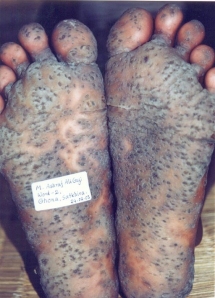
Skin lesions from long-term high level of arsenic poisoning. To learn more about arsenic poisoning and possible exposure, you may watch the videos below:
Arsenic in Bangladesh (Note you can select full screen if you want)
Arsenic concerns in the U.S. (Note you can select full screen if you want)
There is good scientific reason to believe that the level of arsenic in toenails is a good indicator of overall arsenic exposure. You decide to examine whether there is a relationship between the concentration of arsenic in people's drinking water and the concentration of arsenic (As) in their toenails. Twenty-one participants were interviewed regarding use of their private (unregulated) wells for drinking and cooking, and each provided a sample of water and toenail clippings for arsenic (As) analysis.
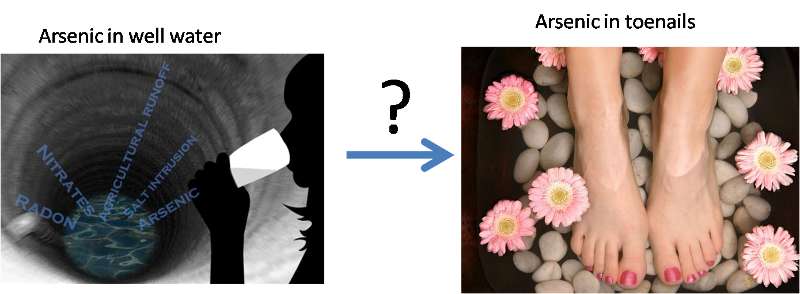
The most important finding is presented below (on the last page of this lesson, there is a video showing how to make the chart below).
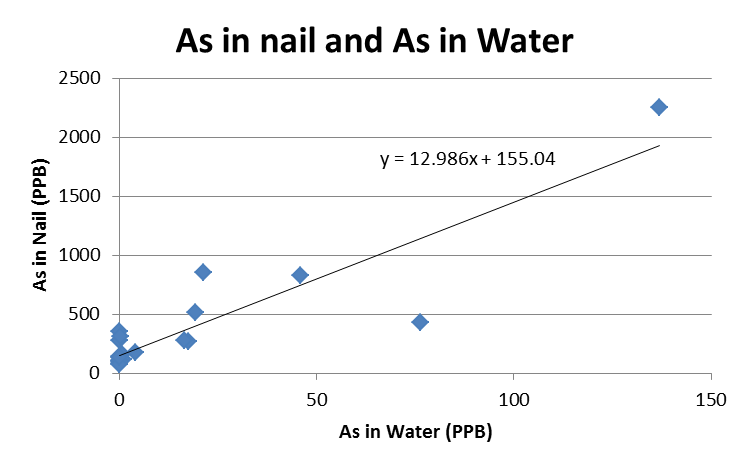
Based on the finding, answer the following four questsions:
- What is the regression coefficient and what does it mean in this setting?
- If a person reduces his/her water arsenic concentration from current 1 PPB to 0.5 PPB, what do your results indicate would happen to the arsenic levels in his/her toe nails?
- If a person reduces his/her water arsenic concentration from current 1 PPB to 0.1 PPB, what do your results indicate would happen to the arsenic levels in his/her toe nails?
- Nicole's current As toe nail level is at 15 PPB, she plans to install a special filter at home that can reduce her drinking water arsenic concentration from current 1 PPB to 0.2 PPB. According to this model, what would be her future As toe nail concentration?
SOLUTION:
Answer to Question #1:
From the scatterplot, we can see that As in nail is positively correlated with As in water, i.e., the higher level of As in water, the higher level of As in nail. The slope of the line is the regression coefficient: 12.986. To interpret this regression coefficient,
1) First, we need to figure out what does "X increases by one unit" mean in this setting.
X-variable in this case is "As in Water (PPB)". So when "X increases by one unit", it means "As in water increases by 1 PPB".
2) Second, we need to find out the "change in Y" (i.e. "Y will change by _____(the regression coefficient)" when X increases by one unit in this setting.
Y-variable in this case is "As in nail (PPB)" and regression coefficient is "12.986", then "Y will change by ____(the regression coefficient)" in this setting would mean "As in nail will change by 12.986 PPB".
Connecting 1) and 2) together, we can interpret the regression coefficient as following:
When As in water increases by 1 PPB, As in nail will change by 12.986 PPB
Answer to Question #2: When As in water changes from current 1 PPB to 0.5 PPB, As in nail will change by = regression coefficient x (Change in X-variable) = 12.986 x (0.5 - 1 PPB) = - 6.5 PPB (i.e. decrease by 6.5 PPB)
Answer to Question #3: When As in water changes from current 1 PPB to 0.1 PPB, As in nail will change by = regression coefficient x (Change in X-variable) = 12.986 x (0.1 - 1 PPB) = -11.7 PPB (i.e. decrease by 11.7 PPB)
Answer to Question #4: When water As concentration changes from current 1 PPB to 0.2 PPB, As in nail will change by = regression coefficient x (Change in X-variable) = 12.986 x (0.2 PPB - 1 PPB) = -10.4 PPB (i.e. decrease by 10.4 PPB); Nicole's current As nail level is at 15 PPB, and according to the model, her future As nail concentration should be = Current As in nail level + "As in nail change by" = 15 PPB + (-10.4 PPB) = 15 PPB - 10.4 PPB = 4.6 PPB.
In general, we can apply the following formula to predict future Y-variable:
Yfuture = Ycurrent + Regression coefficient x (Xfuture - Xcurrent)
Have I Grasped the Key Concepts Here?
Case #1. A study is conducted to evaluate the relationship between Arsenic in nail (PPB) and As in water (PPB), results are presented below:
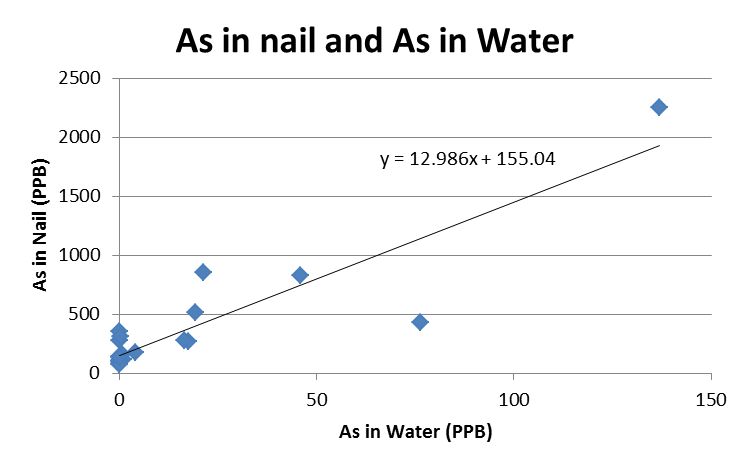
Based on above chart, answer the following questions:
Case #2. You are a health educator for a large local health department where coronary heart disease has been a major problem for your community. To educate public on various ways to reduce total cholesterol, you came across the study shown below.Total cholesterol levels were determined for 51,723 participants of community-based cholesterol screenings in 10 United States cities during 2013. Through linear regression, total cholesterol levels (mg/dL) (Y) was found to be associated with number of cigarettes smoked per day (cigarette/day) (X) for both men and women under the age of 60.
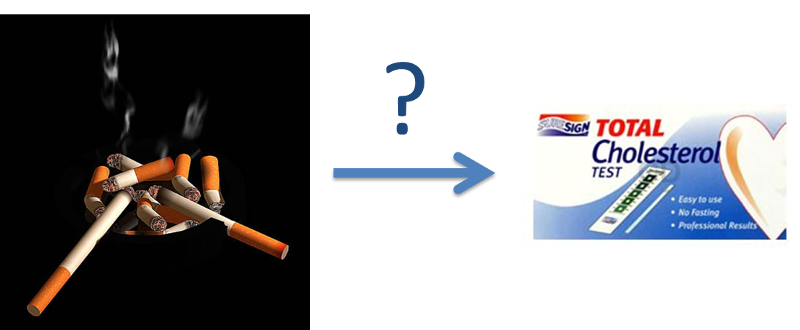
Results of regression analysis are summarized below:
|
Gender |
Regression coefficient b, (mg/dL)/[cigarette/day] |
|
Men aged 18 through 60 |
0.33 |
|
Women aged 31 through 60 |
0.48 |
Based on above study, answer the following questions: